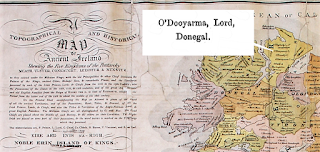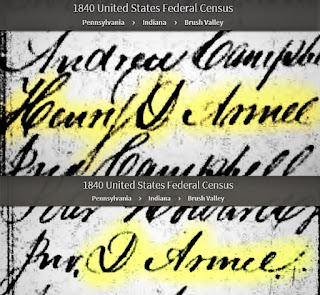The above photo is of the late Catholic priest Father Charles McDermott of the Diocese of Sacramento, California. He was a highly respected cleric who was considered an authority on morality and church law. He was born in the city of Derry (Londonderry), Ireland, a few miles south of Inishowen. To his fellow Irish Catholic priests, he was known as Cathaoir O'Duibhdhiorma. His Irish and Anglicized dual surnames and place of birth and religion are revealing in regard to the history of the clan that produced descendants who became Protestants and used DeArmond surname variants, and those who remained Catholic and used the surname McDermott or McDearmond and other familiar Irish Catholic surnames such as Byrne, Bellew and Lennon.
Ysearch.org Y DNA 37 marker STR results for men who have tested positive
for SNP FGC4113, the Y DNA terminal SNP marker for the clan of
O'Duibhdhiorma. Click on chart to enlarge.
Examining the Y DNA Short Tandem Repeat chart above reveals the distinctive
divide among descendants of the clan of O'Duibhdhiorma between Catholic
and Protestant. The four markers designated with an asterisk denote the
descendants whose ancestors had converted originally to the Presbyterian
religion. 7ZKDS McDearmond did not test for FGC4113 and there is
little information about his immigrant ancestor. His STR results unmistakably
place him among the Connachta Catholics (green) of FGC4113. Bellew did
not transfer his results to Ysearch.org, but he closely matches McDermott. His
ancestor was from Galway, a few miles south of Sligo, and his surname was
undoubtedly originally O'Duibhdhiorma/McDermott. His Bellew surname was
obviously borrowed from the esteemed Catholic Anglo/Norman family (Belleau) of
Mount Bellew in Galway.
Following the failed mid 17th century revolt of the Irish against British rule, perhaps a third of the Catholics of Ireland were forcibly removed to Connachta Province or even further south. The Irish phrase to "To Hell or Connaught" originates from this period. This early forced refugee migration likely accounts for Catholics McDermott and Bellew being from Counties Sligo and Galway. A point of confusion is that County Roscommon in Connachta Province was the home of the large MacDiarmada clans who also used McDermott. This has led to many Catholic descendants with a McDermott or other common Irish surnames mistakenly assuming the wrong source for their paternal ancestry.
Following the failed mid 17th century revolt of the Irish against British rule, perhaps a third of the Catholics of Ireland were forcibly removed to Connachta Province or even further south. The Irish phrase to "To Hell or Connaught" originates from this period. This early forced refugee migration likely accounts for Catholics McDermott and Bellew being from Counties Sligo and Galway. A point of confusion is that County Roscommon in Connachta Province was the home of the large MacDiarmada clans who also used McDermott. This has led to many Catholic descendants with a McDermott or other common Irish surnames mistakenly assuming the wrong source for their paternal ancestry.
17th century cannon on the old walls of Londonderry suggesting how much the native Irish were once considered a threat to the city's survival. The hills of Inishowen are to the north on the horizon. O'Duibhdhiorma history is linked to the city through early warfare, migration, emigration, employment and political/religious/cultural conflict.
According to Brian Mitchell (2010), during the mid 19th century, several descendants of Catholic (and Presbyterian?) O'Duibhdhiorma migrated from eastern Inishowen and environs to Londonderry to work in shirt making factories and the shipyards. Many began using the surname McDermott which today is one of the more common names in Derry.
John O'Donovan (1861) wrote "O'Duibhdhiorma is still numerous in Inishowen, but corruptly anglicized to Diarmid and sometimes rarely to MacDermott, though always pronounced O'Duibhdhiorma by the natives when speaking Irish." O'Donovan was collectively using the Gaelic Diarmid for Anglicized spellings of Dyermott, Diermond, Dermond and Dermott which were usually substituted in Inishowen and Ulster for O'Duibhdhiorma. His mention that McDermot was only used rarely likely reflects the period prior to industrialization in Londonderry. In 1878, Father James O'Laverty wrote "O'Duibhdhiarma (sic), The name is still numerous in Inishowen and in the neighborhood of Derry where it is anglicized to Dooyearma and changed into MacDermot". O'Laverty's comment reflects the time period after the full swing to industrialization in the city of LondonDerry.
In 1973 Brian Bonner, writing about Inishowen, said that O'Duibhdhiorma was rather illogically changed to McDermott, but that the older folks of Inishowen pronounced the surname, "Dee-Erma" which was a more recent Gaelic rendering of the older Anglicized transliteration Dooyearma. A mid 19th century baptism of a Peter Dyermott was recorded in the Moville Parish Catholic church of Inishowen, illustrating how written records were kept using only the substituted Anglicized variants of Irish given name Diarmuid.
The Protestant split from the clan.
Judging from the surviving records of the period during the 17th century forced removals to Connaught (Connacht), less than half of the O'Duibhdhiorma remained in Inishowen afterwards. I would surmise this is reflected in the Y DNA results shown above. About 1725, the Presbyterian Ulster Scots began a 50 year long mass migration to North America leaving behind vacant tenant farming positions that were filled by native Irish provided they convert to a Protestant religion which in most cases was Presbyterian. They became integrated among the Ulster Scots and became part of their migration also. A few Protestant converted O'Duibhdhiorma remained in Ulster or migrated to Scotland, England and then on to North America and Oceana. They can be found today in the environs of Belfast with surnames like Deyermond. Protestant O'Duibhdhiorma can also be found in mid 19th Glasgow using McDermid for a surname and having American, Canadian and Australian descendants test positive for Y DNA SNP FGC4113 or have autosomal DNA matches to DeArmond descendants.
Note from his book by Father Patrick Woulfe in 1906. His informant was likely to have been a Catholic priest in Belfast who was amused by this attempt to change a native Irish surname into various pseudo Protestant French Huguenot surnames. The fashion actually began in America following the celebrated return tour of America by the famed Marquis de Lafayette in 1824-5.
Very little is known about the Protestant converted O'Duibhdhiorma before their18th century emigration among the Ulster Scots to America, since nearly all writings about the O'Duibhdhiorma in Ireland were by native Irish Catholics, who were often priests who had no interest in Protestants. Except for Father Patrick Woulfe (1906) who noted the "assimilation" of pseudo "French" spellings for O'Duibhdhiorma substitutions (see above).
Perhaps DeArmond surname variant researchers in the
future will have a more substantial data base of Y DNA results to work with and
be able to determine ports of departure, either Londonderry or Belfast. Contrary to widespread belief, I strongly suspect the overwhelming majority of Protestant immigrant surname ancestors were from County Donegal and sailed from Londonderry, as opposed to Roscoe C. "d'Armand" who would have most of his immigrant lines be from County Down and embark from Belfast or else from England where their noble French surname had not been "corrupted" by Irish influence. My belief stems from a search of the 1796 Flax Growers bounty lists for County Down that reveal not a single possible surname variant of DeArmond, whereas the surname is abundantly found in County Donegal. This and a lack of any other record in Counties Antrim (Lisburn) and Down before 1800 suggest the surname was unknown there until sometime in the 19th century.
Probable migration and emigration routes and time periods for O'Duibhdhiorma clan Catholics and Protestants. These represent the primary movements of male line clan descendants. Isolated examples of Y DNA test results show that individual clan descendant men carried their Y chromosome to other countries of the world as well. The Catholics in particular often borrowed surnames not recognizable as specific to the clan.
Probable migration and emigration routes and time periods for O'Duibhdhiorma clan Catholics and Protestants. These represent the primary movements of male line clan descendants. Isolated examples of Y DNA test results show that individual clan descendant men carried their Y chromosome to other countries of the world as well. The Catholics in particular often borrowed surnames not recognizable as specific to the clan.



















